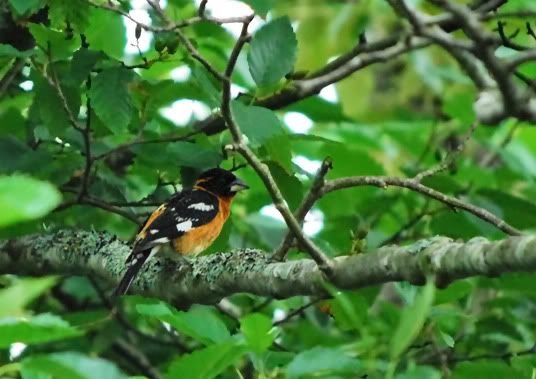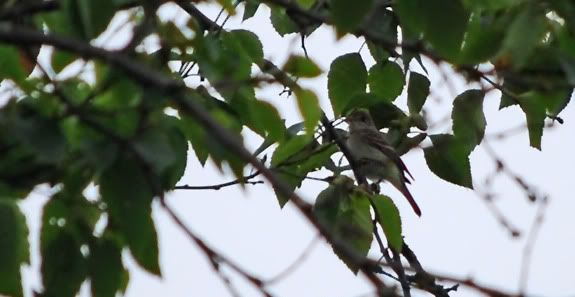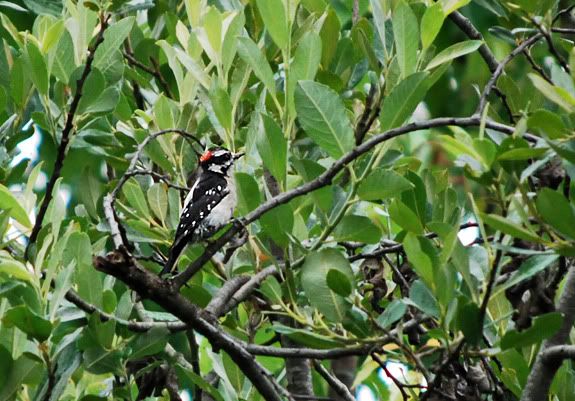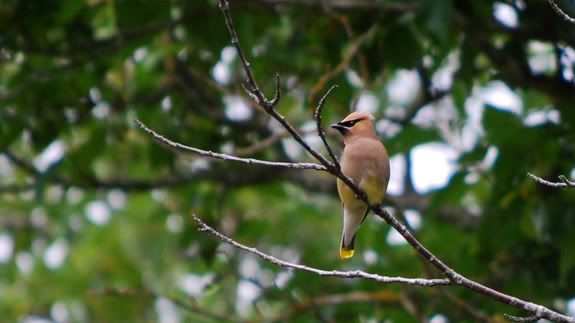Here are some of the birds I saw last Monday:
Black-headed grosbeak. This was a first for me! We saw two males chasing each other around the trees.

American goldfinch. These guys were everywhere - mostly flying overhead calling "potato chip! potato chip! potato chip!"and chowing down on thistle seeds. I sometimes get these mixed up with yellow warblers (next) because they're about the only bright yellow birds that tiny. Apart from the black marking on the goldfinch that set it apart, I also find the posture to be different - the goldfinches stand more upright, whereas the warblers are more tilted forward.

Yellow warbler!

Spotted towhee. These striking birds are everywhere in this area, and aren't shy about hopping out onto branches and getting their picture taken. They have really strange and varied calls (what I thought for years to be squirrel chatter actually turned out to be a towhee), and you often hear them scratching around in the brush.

We weren't able to identify this guy for sure - I think it might be a Western wood pewee, but I'm not very familiar with flycatchers. If anyone has any ideas, I would be grateful for the insight!

Downy woodpecker. Downies look a lot like their slightly larger cousins, the hairy woodpeckers. Apparently the best way to tell them apart is the length of the beak relative to their head - if the beak is about the same length as the head, it's the bigger Hairy, but if the beak is shorter than the head, it's the diminutive Downy. The bright red patch on this guy also indicates he is a male. :)

Cedar waxwing. These birds are also super common in the area, especially around berry bushes! I often hear them before I see them - they make a high pitched, almost digital insect sound. I think these birds are so pretty - they look so much better put-together than other birds, like they're made of painted ceramic.

Juvenile bald eagle. Young eagles take up to 5 years to attain sexual maturity and get the famous white head and tail.

More pictures (including a groovy orange slug) to come!

Beautiful photos! The flycatchers can be a tricky bunch, sometimes the best way to distinguish is through their vocalizations. Really looking forward to seeing the orange slug!
ReplyDeleteGreat pictures!
ReplyDeleteFollowing you from the Great Canadian link exchange :)
I know loosestrife is invasive but it's so pretty...I wonder where it's native to and how it was brought into canada. Have you come across anything on the zebra mussels in the lakes up there? I know they were pretty bad a few years back.
ReplyDeleteThat towhee is amazing with its red eyes!! I love it. I also am pretty sure I saw an immature bald eagle last week in massachusettes, it looked just like that. And I have always thought that cedar waxwings look almost fake, like ceramic birds! Their feathers blend so well.
Woodpeckers are still my fave, though. Perky little guys get me every time.